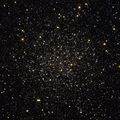Astronomy:Messier 12
| Messier 12 | |
|---|---|
 Globular cluster Messier 12 in Ophiuchus | |
| Observation data (J2000 epoch) | |
| Class | IX[1] |
| Constellation | Ophiuchus |
| Right ascension | 16h 47m 14.18s[2] |
| Declination | –01° 56′ 54.7″[2] |
| Distance | 16.44 ± 0.16 kly (5.04 ± 0.05 kpc)[3] |
| Apparent magnitude (V) | 6.7[4] |
| Apparent dimensions (V) | 16.0′ |
| Physical characteristics | |
| Mass | 8.7×104[5] M☉ |
| Radius | 37.2 ly[NB 1] |
| Metallicity | = –1.14[6] dex |
| Estimated age | 13.8 ± 1.1 Gyr[3] |
| Other designations | NGC 6218[7] |
Messier 12 or M 12 (also designated NGC 6218) is a globular cluster in the constellation of Ophiuchus. It was discovered by the French astronomer Charles Messier on May 30, 1764, who described it as a "nebula without stars".[8] In dark conditions this cluster can be faintly seen with a pair of binoculars. Resolving the stellar components requires a telescope with an aperture of 8 in (20 cm) or greater.[9] In a 10 in (25 cm) scope, the granular core shows a diameter of 3′ (arcminutes) surrounded by a 10′ halo of stars.[8]
M12 is roughly 3°[9] northwest from the cluster M10 and 5.6° east southeast from star Lambda Ophiuchi. It is also located near the 6th magnitude 12 Ophiuchi.[10] The cluster is about 16,400 light-years (5,000 parsecs)[3] from Earth and has a spatial diameter of about 75 light-years. The brightest stars of M12 are of 12th magnitude. M10 and M12 are only a few thousand light-years away from each other and each cluster would appear at about magnitude 4.5 from the other.[10] With a Shapley-Sawyer rating of IX,[1] it is rather loosely packed for a globular and was once thought to be a tightly concentrated open cluster. Thirteen variable stars have been recorded in this cluster. M12 is approaching us at a velocity of 16 km/s.[11]
A study published in 2006 concluded that this cluster has an unusually low number of low-mass stars. The authors surmise that they were stripped from the cluster by passage through the relatively matter-rich plane of the Milky Way.[12]
-
Messier 12 core by HST
-
The Central Part of Messier 12. Credit: ESO
-
Map showing the location of M12
See also
Notes
- ↑ distance × sin( diameter_angle / 2 ) = 37.2 ly radius
References
- ↑ 1.0 1.1 Shapley, Harlow; Sawyer, Helen B. (August 1927), "A Classification of Globular Clusters", Harvard College Observatory Bulletin 849 (849): 11–14, Bibcode: 1927BHarO.849...11S.
- ↑ 2.0 2.1 Goldsbury, Ryan et al. (December 2010), "The ACS Survey of Galactic Globular Clusters. X. New Determinations of Centers for 65 Clusters", The Astronomical Journal 140 (6): 1830–1837, doi:10.1088/0004-6256/140/6/1830, Bibcode: 2010AJ....140.1830G.
- ↑ 3.0 3.1 3.2 Gontcharov, George A.; Khovritchev, Maxim Yu; Mosenkov, Aleksandr V.; Il'In, Vladimir B.; Marchuk, Alexander A.; Savchenko, Sergey S.; Smirnov, Anton A.; Usachev, Pavel A. et al. (2021). "Isochrone fitting of Galactic globular clusters – III. NGC 288, NGC 362, and NGC 6218 (M12)". Monthly Notices of the Royal Astronomical Society 508 (2): 2688–2705. doi:10.1093/mnras/stab2756.
- ↑ "Messier 12". https://messier.seds.org/m/m012.html.
- ↑ Marks, Michael; Kroupa, Pavel (August 2010), "Initial conditions for globular clusters and assembly of the old globular cluster population of the Milky Way", Monthly Notices of the Royal Astronomical Society 406 (3): 2000–2012, doi:10.1111/j.1365-2966.2010.16813.x, Bibcode: 2010MNRAS.406.2000M. Mass is from MPD on Table 1.
- ↑ Forbes, Duncan A.; Bridges, Terry (May 2010), "Accreted versus in situ Milky Way globular clusters", Monthly Notices of the Royal Astronomical Society 404 (3): 1203–1214, doi:10.1111/j.1365-2966.2010.16373.x, Bibcode: 2010MNRAS.404.1203F.
- ↑ "M 12". SIMBAD. Centre de données astronomiques de Strasbourg. http://simbad.u-strasbg.fr/simbad/sim-basic?Ident=M+12.
- ↑ 8.0 8.1 Thompson, Robert Bruce; Thompson, Barbara Fritchman (2007), Illustrated guide to astronomical wonders, DIY science O'Reilly Series, O'Reilly Media, Inc., p. 137, ISBN 978-0596526856, https://books.google.com/books?id=ymt9nj_uPhwC&pg=PA137.
- ↑ 9.0 9.1 Monks, Neale (2010), Go-To Telescopes Under Suburban Skies, Patrick Moore's Practical Astronomy Series, Springer, p. 118, ISBN 978-1441968500, https://books.google.com/books?id=waO6tUtfblsC&pg=PA118.
- ↑ 10.0 10.1 O'Meara, Stephen James; Levy, David H. (1998), Deep-Sky Companions: The Messier Objects, Cambridge University Press, p. 68, ISBN 978-0521553322, https://books.google.com/books?id=jis4evHuuzUC&pg=PA68.
- ↑ "Messier 12: Gumball Globular | Messier Objects". 11 March 2015. http://www.messier-objects.com/messier-12-gumball-globular/.
- ↑ How to Steal a Million Stars?, ESO, February 7, 2006, http://www.eso.org/outreach/press-rel/pr-2006/pr-04-06.html.
External links
| Wikimedia Commons has media related to Messier 12. |
- Messier 12, SEDS Messier pages
- Messier 12, Galactic Globular Clusters Database page
- 'Stolen' stars article at Universe Today
- Messier 12, Amateur astrophotographer (hgg) with a Celestron 9.25"
- Messier 12 on WikiSky: DSS2, SDSS, GALEX, IRAS, Hydrogen α, X-Ray, Astrophoto, Sky Map, Articles and images
Coordinates: ![]() 16h 47m 14.52s, −01° 56′ 52.1″
16h 47m 14.52s, −01° 56′ 52.1″
 |





